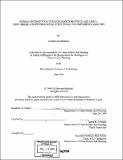Energy-intensity factors for Shanxi Province and China : shift-share and interregional structural decomposition analysis
Author(s)
Shirvani-Mahdavi, Ali (Ali Agha), 1965-
DownloadFull printable version (9.599Mb)
Other Contributors
Massachusetts Institute of Technology. Dept. of Urban Studies and Planning.
Advisor
Karen R. Polenske.
Terms of use
Metadata
Show full item recordAbstract
In this study, I examine the underlying factors for the current energy-intensity levels in China, and its major coal-producing provinces, Shanxi Province, using an interregional (spatial) Structural Decomposition Analysis (SSDA), and shift-share analysis (SSA). The results of SSA show that Shanxi Province consistently had energy-intensity levels three times as great as China for the 1986-1995 period. Furthermore, in almost every year, in both China and Shanxi Province, the primary reason behind reductions in energy-intensity levels was an improvement in energy efficiency, due to the growth of the economy, and the introduction of new technologies. However, the sector most responsible for this shift was the heavy-industrial sector in China, but the transportation sector in Shanxi Province. The SSDA analysis showed that in 1992, only 12.8 percent of the difference in Renminbi (RMB) of energy input between Shanxi Province and China can be attributed to changes in final demand. Production-technology differences in the five energy sectors accounted for almost ninety percent of the difference, while the differences in the 28 non-energy sectors accounted for over 450 percent of the 545 percent of the total. Four policy options were recommended to bridge the gap in energy-intensity levels between Shanxi Province and China. (1) continuing the market reform of Shanxi Province based on the lessons learned on China's coastal regions; (2) further incorporating Shanxi Province's economy into the global economy; (3) clarifying the roles of central and Shanxi Province's governments during the transition period; and (4) implementing a regional development strategy that emphasizes building infrastructure, particularly in the transportation sector, and environmental preservation.
Description
Thesis (M.C.P.)--Massachusetts Institute of Technology, Dept. of Urban Studies and Planning, 1999. Includes bibliographical references (leaves 145-150).
Date issued
1999Department
Massachusetts Institute of Technology. Department of Urban Studies and PlanningPublisher
Massachusetts Institute of Technology
Keywords
Urban Studies and Planning.